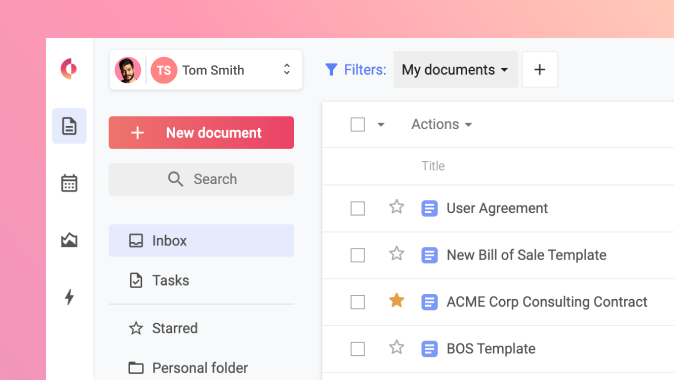5 Best Practices for Organizing Your Contracts
This is the second in a series of four posts covering the essentials of contract organization: why it matters, best practices, key benefits, and what can go wrong.
Read Part One in our series.
Best practices to contract organization
Becoming the revenue leader and strategic player requires a strong foundation. In contract management, that foundation is your organization. Here’s an in-depth look at the best practices you need for effective, efficient contract management to help you start leveraging your contracts to be more impactful, and more successful.
1. Ownership
Too many cooks spoils the broth. Too many cowboys, not enough grunts. You get the picture.
Every software solution, just like every project, should have an owner—and your contract lifecycle management solution is no different. In contract management that owner is usually the Legal team. Because the Administrator has no restrictions on actions and complete access, this is the final stop for questions, training, and future planning.
Best practice to consider for administrators
Enable your teams by holding regular calls with them, especially the sales team, to hear about their upcoming opportunities and deals. Advising them on what legal documents they’ll need makes sure the deal keeps moving, putting you ahead of the curve, and a big step closer to becoming strategic.
Your contract lifecycle management solution should automate this for you through the use of templates with built-in approval workflows and user groups, so you can push out any necessary updates to the right people with the click of a button, and guarantee compliance.
2. Cloud vs. physical
Everything is in the cloud these days. And for good reason. Now, that’s not to say physical doesn’t have some perks (we suppose). But the benefits to storing your data in the cloud far outweigh any benefits a bulky filing cabinet (or several depending on how many contracts you have or the size of your company) might present.
Five big benefits of cloud-based contract management and why it’s a best practice
- The amount of physical space saved.
- Cloud storage is incredibly secure, and cloud services backup their servers (yours should be) to prevent any data loss.
- Convenience. You can store unlimited data and search it all in a quarter of a second. You can have all of your contracts and contract information, ALL OF IT, in one place—this includes contracts signed on your contract lifecycle management platform or off.
- Collaboration is incredibly easy. You can share data around the world with the click of a button.
- The digital nature of cloud storage enable next-generation contract management platforms to run robust analytics.
What’s more with best-in-class cloud-based contract management platforms, you get in-contract negotiation, including the ability to insert appropriate required fields and assign them to the correct person, make comments and edits within the document online, and have a well-documented history with simple version control. It’s powerful features like these that make cloud-based contract management a clear winner.
3. Tagging
Tags are the backbone of your document structure, and the foundation of your contract management success. Like the molecular structure of your DNA, tags standardize your naming structure and classify your contracts in a way that makes them easy to find, while enabling more powerful reporting.
Tagging – your naming convention
Having a clear, concise structure will help you:
- Locate and organize documents.
- Automate the process of giving your team access to documents.
- Control who has access to categories or groups of contracts.
- Easily retrieve your contracts—increases efficiency and makes for powerful reporting that will ultimately help you forecast budgets and drive more business value.
Things to keep in mind for tagging best practices
- Creating sub-tags will allow you to create Folders and Subfolders for your documents.
- Consider creating tags by:
- Department (e.g., Legal, Sales, Marketing, HR, Procurement)
- Contract type (e.g., Supplier contracts, NDA)
- Recurring projects (e.g., Service Agreements, Consulting Projects)
- Restrict the number of users who will be allowed to create new tags.
- Avoid creating tags for suppliers or clients. Instead use your solution’s global search tool and search for “Signed with” to pull up a specific supplier or client contract.
- Having the right tags on your templates makes them easily retrievable, and able to be shared automatically, and in seconds, with the right people, based on your defined groups and users (next step).
4. Structuring and Segmentation
When it comes to contract organization best practices, specifically regarding compliance, enabling administrators to grant different levels of permission and access to specific user profiles is key.
Roles, user groups, and permissions
With roles, administrators can choose who has the right to perform particular actions on your contract lifecycle management platform, i.e. the right to sign a contract, to modify a template, delete a contract, etc. These user groups or access rights can then be used to set approval workflows—customizable workflows that route to the appropriate user or group that reflect established company practices for approval and signatures.
Roles allow you to define what actions particular team members can perform, and you can grant users and teams access to specific folders using tags. Your contract lifecycle management platform might start you out with three predefined system roles—Administrator, Users, and Read-only, but should enable you to create as many customized roles as you need.
Two types of roles to consider implementing
- System roles, typically created or system defined roles of Administrator, User, and Read Only.
- Custom roles that allow you to define permitted and prohibited actions. In best-in-class solutions administrators can define an unlimited number of custom roles to align with internal processes of the customer organization.
Creating teams of users streamlines the processes of giving users access and organizing your team. In addition, using the team structure will enable you to automate document management while keeping control over document access.
User group best practices
- Create a team for each department: Sales, Marketing, HR, Legal, Procurement, etc. This makes creating and defining custom roles easier, as well as granting access or permission.
**If you are planning on adding many users to a particular role, set up this role as a default prior to inviting your users, and double check your Administrator role is not the default role.
5. Approval workflows – easy compliance & efficiency
More than a central repository for your contracts, using automated approval workflows within your contract management solution streamlines your contract management processes by quickly moving contracts from one step to the next. Instead of spending 80% of your time doing administrative work you can focus on adding value.
Because not everyone sends their documents to legal (even though they should), setting approval workflows at the template level guarantees that those users, or user groups, that generate contracts from this template will have the appropriate approvals in place from the start. No one will ever have to chase down an approver or shy away from Legal.
Best practice when it comes to compliance?
Curb issues before they become issues. With approval workflows you get baked-in compliance. You are able to reduce risk and can easily keep up with growth while maintaining compliance standards.
In Part Three, we’ll look at the key benefits of superior contract organization.
Want to learn more?
Concord’s mission is to help companies achieve scalability and efficiency by automating their most central process, contracts. The cloud-based solution enables over 300,000 users around the globe to create, collaborate, sign, store, and manage their agreements all in one place. Founded in 2014 and headquartered in San Francisco, Concord is built by business for business.



